
Just as last month I couldn’t legitimately assign the Greek stew kydonato to a single wine region, so, this month, my subject is another free-ranging dish—one with an even greater reach: ceviche. Raw fish or seafood marinated in citrus juices to coagulate the proteins is found in myriad variations in Hispanic American countries, especially, but not only, those with borders on the Pacific Ocean. One of my early encounters with ceviche (cebiche, sebiche, or seviche) was a cookery class in London at which we prepared Argentine recipes and then paired wines with them, more of which later.
Such is many Chileans’ enthusiasm for the dish that any first-time visitor to Chile might well assume that they were in the birthplace and contemporary heartland of ceviche, but Peru’s claim is greater. There is evidence that in the coastal regions of northern Peru the Moche civilisation (circa 100–800 AD) ate their fish raw, with similar evidence for the succeeding Chimú and Inca cultures. In his 1534 Verdadera Relación de la conquista del Peru, Francisco de Xerez, the explorer and chronicler who became the personal secretary of the conquistador Francisco Perez, wrote that the native people ate “meat and fish, all raw.”
Pre-Columbian peoples would have had chili peppers, but no citrus fruit, nor indeed the onions that now feature in almost all ceviche recipes. It has been suggested that they marinated their fish in chicha de jora (Peruvian corn beer), or that they used tumbo, a relative of passion fruit, but Maricel Presilla, author of the seminal Gran Cocina Latina: The Food of Latin America, believes that tumbo is too slow-acting. She thinks a combination of acidic local chillies and cochayuyo, a type of kelp still used in some coastal cevicherias and for vegan ceviches, are more likely.
The first documented mention of ceviche is said to be in an 1820 Peruvian patriotic song. I can’t confirm this, but the first known recipe (or detailed description) is verifiable. It appeared in 1866 in Lima Or Sketches of the Capital of Peru, Historical, Statistical, Administrative, Commercial, and Moral by the remarkable Manuel Atanasio Fuentes (described among other things as census-taker, statistician, journalist, administrator, social commentator, political satirist, historian, advocate, and medical expert).
Writing of “the picantes (spiced dishes),” under the heading National Repasts, he says, “the most biting picante, that which most often compels tears, is the seviche. It is composed of small pieces of fish or crabs, soaked in the juice of bitter oranges with plenty of pimento and salt. After lying for some hours till the fish is thoroughly impregnated, and cooked, as it were, by its burning effect and the acidity of the orange-juice, it is ready for the table.” Contemporary ceviche has moved on, although there is still a saying, “If you don’t cry with ceviche, it’s not a good ceviche.”
Bolstering Peru’s claim on ceviche, UNESCO added it to its prestigious Intangible Cultural Heritage of Humanity list for Peru in December last year, highlighting the dish’s role in the country’s cultural identity, the importance of artisanal sustainable fishers and traditional female ceviche cooks in cevicherías, regional variations and the way knowledge of ingredients and preparation are passed down through families. Since 2004, Peru has also had a ceviche national day, El Día Nacional del Cebiche on June 28.
UNESCO’s citation mentions regional variations. In Peru: The Cookbook (2015, Phaidon) by the chef and ambassador of Peruvian cuisine Gastón Acurio, there are Amazonian, Piurano, Trujillano, and Arequipa ceviches. There are also Nikkei, Chinese, and Italian-style recipes and some (among the total of 24) that are based on, for example, mushrooms, artichoke, duck, and snails instead of fish. In Acurio’s words, “Ceviche is a blank canvas, not just a recipe”. For the purposes of this article, however, I shall stick to traditional fish/seafood ceviches of the sort that UNESCO recognised.
How to make ceviche
The traditional ceviche marinade is leche de tigre (tiger milk), made from lime juice, fish broth (stock), chillies, sliced onion, and sometimes cilantro (coriander leaf), garlic, celery stalk, ginger, and/or other flavorings, but often the marinade is a similar but simpler affair omitting the broth.
The type of fish varies widely, but for a classic Peruvian ceviche it is generally a firm-fleshed white fish (Gastón Acurio often suggests sole, croaker, or grouper,) and the flesh is cut into cubes. Halibut is common in Chile (among many other fish) and it’s a fish that works well for ceviche here in the UK.
How long it should be marinaded is a moot point. Chefs like Acurio usually serve it more or less immediately, while the fish is still firm, but in the past it was left longer (as in the 1866 recipe) and there are still recipes today that recommend a minimum of 20 minutes and up to three hours. The Nikkei people, with their sashimi tradition, are often credited with introducing the shorter times.
Serving ceviche within two or maximum three minutes of its preparation means having accompanying wine chilled and to hand—chilled because successful pairings for ceviche are almost entirely limited to white wines. The wine needs high enough acidity to balance that of the citrus juice and onion, ruling out almost all red wines and most rosé (rosés with high enough acidity tend to have been so early picked that they are short of other flavors). The few skin-contact whites that I have tried have not worked either: the acidity has been too low or the flavors too assertive, or both.
The best wines to pair with ceviche
The grape variety that I find works best overall is Sauvignon Blanc. It’s perhaps the reason that Chile sometimes seems to have taken ownership of ceviche: Chile has Sauvignon Blancs, often from vineyards near the Pacific Ocean, that have the union of precision, intensity, pristine acidity and saline character that pairs so well with ceviche. Two such are Ventisquero Grey Sauvignon Blanc 2023 and Kalfu Sumpai Sauvignon Blanc 2022, both from Atacama, the world’s driest desert, but from vineyards only 22km (14 miles) and less than 20km (12 miles) from the sea, respectively.
As for Peru, although vine cultivation probably predated that in Chile and Argentina, decline set in with the arrival of phylloxera in 1888 and a revival didn’t get underway until the 1970s. A handful of wineries grow and bottle Sauvignon Blanc, including Tacama, Queirolo, and Apu Winery (the latter from vineyards at 2,850m [9,350ft]), but it’s on a small scale and I am not familiar with them.
Outside South America, I would look to Marlborough and specifically to its cooler Awatere subregion for a wine such as Spoke Awatere Sauvignon Blanc 2023, or to South Africa for a wine such as Klein Constantia’s stony, mineral, predominantly wild-fermented 2022 Sauvignon Blanc.
Beyond Sauvignon, Riesling, Chenin Blanc, Assyrtiko, and Albariño/Alvarinho are grape varieties that can work in particular styles and from particular places.
Riesling usually has the acidity for ceviche, but the fruit can be too bright, or, in the case of bone-dry Clare Valley Riesling, can have too much lime-intensity for a fish like halibut. But a recent spot-on pairing was a halibut ceviche with lime caviar and elderflower jelly, specially created by chef Chris Hannon of Cliveden House hotel to go with an Oregon Riesling, the off-dry, petrol-edged Phelps Creek Underwood Mountain Vineyard Riesling 2021. It’s a pairing worth mentioning but, as Hannon said, this is a classic way of preparing ceviche but with a lighter touch, holding back on the chili.
Like Riesling, Chenin Blanc is not a shoo-in with ceviche but bone-dry Savennières, with steeliness and no more than a whisper of honey, can hit it off, for example, Domaine des Baumard Clos du Papillon 2019; likewise, Santorini Assyrtiko, avoiding the most powerful and penetratingly mineral; Rías Baixas Albariño, especially from the cooler, wetter Salnés subregion; and top-quality Vinho Verde Alvarinho from producers such as Anselmo Mendes and Soalheiro.
One grape variety that I struggle to pair with ceviche is Torrontés, the grape variety chosen to pair with the Argentine ceviches at the cookery class I attended years ago. Even the finer, more complex Argentine Torrontés being made today seem too aromatic for ceviche, but if you are tempted, I would suggest a ceviche based on sweeter shellfish, especially shrimp/prawn.






